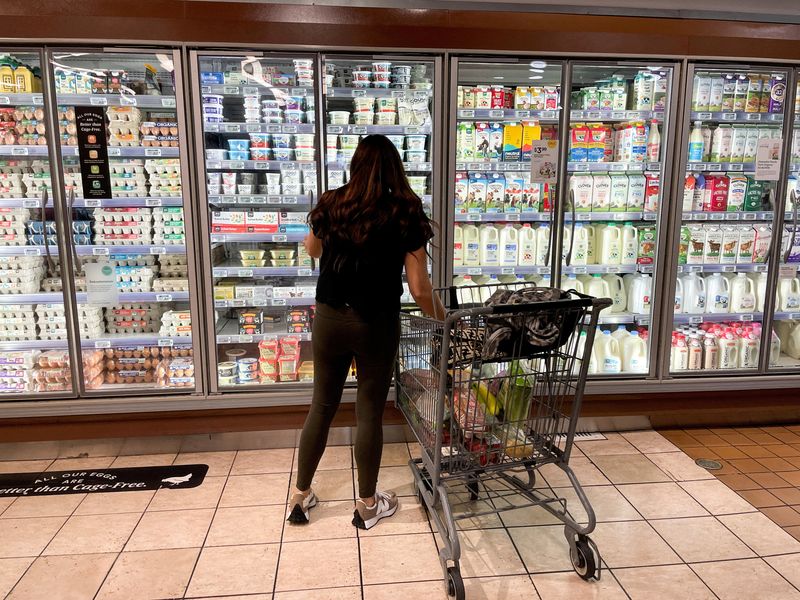By Lucia Mutikani
WASHINGTON (Reuters) - U.S. consumer prices increased solidly in February as Americans faced persistently higher costs for rents, posing a dilemma for the Federal Reserve, whose fight against inflation has been complicated by the collapse of two regional banks.
Economists disagreed on whether the report from the Labor Department on Tuesday, which also showed underlying consumer prices rising by the most in five months, would compel the Fed to prioritize bringing inflation under control or focus on financial markets stability.
Some expected a quarter-point interest rate hike while others believed a pause in the U.S. central bank's fastest monetary policy tightening cycle since the 1980s was likely when policymakers meet next Tuesday and Wednesday. Regulators have taken emergency measures to shore up confidence in the banking system following the collapse of Silicon Valley Bank in California and Signature Bank in New York.
"The Fed is going to have to pick its poison, tolerate some inflation for a bit to see if its current series of rate hikes takes hold and pause or keep hiking and deal with the financial instability caused by their own policy decisions," said Jamie Cox, managing partner at Harris Financial Group in Richmond, Virginia.
The Consumer Price Index (CPI) rose 0.4% last month after accelerating 0.5% in January. Shelter, which includes rents as well as hotel and motel accommodation, accounted for more than 70% of the increase in the CPI.
Though food prices rose 0.4%, the cost of food consumed at home gained 0.3%, the smallest increase since May 2021. There was a 1.0% jump in the cost of nonalcoholic beverages. Prices for fruits and vegetables increased moderately.
But meat cost less and egg prices fell 6.7%, offering some relief for consumers, whose purchasing power has been eroded by inflation. While gasoline prices increased 1.0%, the cost of natural gas decreased 8.0%, the biggest drop since October 2006.
In the 12 months through February, the CPI increased 6.0%, marking the smallest year-on-year gain since September 2021. The CPI rose 6.4% on a year-on-year basis in January.
The annual CPI peaked at 9.1% in June, which was the biggest increase since November 1981. The increase in the CPI in February was in line with economists' expectations.
Despite the signs of moderation, monthly inflation is still rising at double the rate that economists say is needed to bring inflation back to the Fed's 2% target.
U.S. stocks rose, with traders betting on a 25 basis points rate hike as the most likely outcome next Wednesday. The dollar gained versus a basket of currencies. U.S. Treasury prices fell.
STRONG SERVICES INFLATION
Fed Chair Jerome Powell told lawmakers last week that the U.S. central bank would likely need to raise rates more than expected, leading financial markets to expect that a half-percentage-point rate increase was on the table next week.
But those expectations were dialed back to 25 basis points after Friday's employment showed a still-tight labor market, but cooling wage inflation.
While financial markets on Tuesday still expected a quarter-percentage-point hike, according to CME Group's (NASDAQ:CME) FedWatch tool, fear of contagion from the banking crisis led some economists, including those at Goldman Sachs (NYSE:GS), to believe the Fed would keep rates unchanged. The Fed has increased its benchmark overnight interest rate by 450 basis points since last March from the near-zero level to the current 4.50%-4.75% range.
"File this one away to reconsider after markets settle down," said Chris Low, chief economist at FHN Financial in New York. "There is still clearly enough inflation to keep the Fed active, even if the (policy-setting) committee must first take a meeting or two to calm markets."
Excluding the volatile food and energy components, the CPI increased 0.5%, the biggest gain since September, after climbing 0.4% in January. A 0.7% increase in owners' equivalent rent (OER), a measure of the amount homeowners would pay to rent or would earn from renting their property, was the main driver of the rise in the so-called core CPI.
Last month's rise in the OER matched January's advance. With
independent measures showing rents on a downward trajectory, some analysts worried that housing was overstating core CPI. The rent measures in the CPI tend to lag the independent gauges.
"Housing costs are dropping yet the flawed methodology of using outdated leases, has today's data showing another laughable large jump in housing costs," said Bryce Doty, senior portfolio manager at Sit Fixed Income Advisors in Minneapolis, Minnesota. "The reality is rents and home prices are falling so core CPI is running closer to a 3.5% annualized rate."
With hotel and motel rooms also costing more, and airline fares rebounding 6.4% after four straight monthly declines, services prices rose 0.5%. That followed January's 0.6% increase. Excluding rents, services gained 0.1% after advancing 0.6% in February.
According to economists' calculations, prices of core services outside housing climbed 0.5% after rising 0.4% in January. These prices are being monitored by policymakers to gauge their progress in taming inflation.
The upward pressure in overall core inflation was despite an eighth straight monthly decline in the prices of used cars and trucks. With auction prices rising in recent months, economists expect a rebound in March.
Apparel prices rose and household furnishings and operations cost more. Still, core goods prices were unchanged after increasing in January for the first time since August.
(Graphic: As goods inflation eases, services step in - https://www.reuters.com/graphics/USA-FED/INFLATION/lbvgndazapq/chart.png)

In the 12 months through February, the core CPI gained 5.5%. That was the smallest rise since December 2021 and followed a 5.6% advance in January.
"Inflation remains a thorn in the Fed’s side and the February CPI supports our baseline forecast for a 25bps increase in the fed funds rate," said Ryan Sweet, chief U.S. economist at Oxford Economics.
